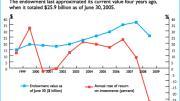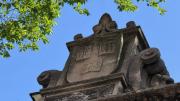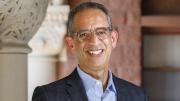Harvard’s endowment was valued at $26.0 billion as of June 30—29.5 percent less than the record $36.9 billion at the end of the prior fiscal year. That result reflects a negative 27.3 percent investment return on endowment assets after expenses and fees; plus capital gifts received; minus the distribution of about $1.7 billion from the endowment to support University operations during the year. The latter amount represents an increase over the funds distributed in fiscal year 2008; details presumably will be forthcoming with the publication of the annual financial report (See October 16 online update, published after this issue went to press: "Harvard's Annual Financial Report Fully Details 2009 Losses"). Reduced endowment distributions in the current and next fiscal years, mandated by the Harvard Corporation in response to the investment losses, are driving cost-cutting throughout the University.
The large loss was not a surprise: as Harvard Management Company (HMC) president and CEO Jane L. Mendillo noted in her annual communication to the community, “Clearly, the last year was a difficult one for Harvard as it was for almost all institutional investors.” Last December, the University had forecast a 30 percent decline; there were concerns that private-equity and real-estate losses might drive even deeper declines. Thus, HMC’s negative 27.3 percent return was within the forecast range, and even modestly positive—by a billion dollars. (Nor was Harvard’s experience unique. Yale reported a negative 24.6 percent investment return and, after distributions and gifts, a 28.8 percent decline in the value of its endowment, from $22.9 billion in 2008 to $16.3 billion as of last June 30. Princeton reported a negative 23.7 percent investment return. But in a surprising show of fiscal prowess, Princeton was able to operate without taking any endowment distribution during the year—funding operations instead through the proceeds of a debt offering last winter, and thus avoiding distressed sales of endowment assets during the most adverse securities markets. The endowment declined from $16.3 billion to $12.6 billion during the year.)
But the result was bruising enough. The “policy portfolio,” HMC’s asset-diversification model, returned negative 25.2 percent as measured by the investment benchmarks for each asset class—2.1 percent better than HMC’s actual performance. And the median large investment fund in the Trust Universe Comparison Service returned negative 18.2 percent: a very large loss, but a significant margin of outperformance relative to Harvard, in a year when conventional stock and bond portfolios proved much more rewarding than the complex assets that have given HMC decades of returns higher than other institutional investors’.

HMC’s results this year appear in a new format (see www.hmc.harvard.edu/investment_performance/2009_performance.php), and are not exactly comparable to detailed results reported in prior annual letters. There are fewer, more aggregated categories than in years past or than exist in the policy portfolio (which details assets by domestic and foreign equities, emerging markets, private equities, absolute return or hedge funds, commodities, real estate, and four fixed-income classes, plus cash). The results (see chart) show modestly lesser losses, compared to market benchmarks, in two broad classes: public equities (in the past, about one-third of endowment assets) and “real assets”—a broad category (in the past totaling about one-quarter of investments)—including commodities; timber and agricultural land; and real estate, where commercial assets are likely still deteriorating in value. Fixed-income assets (in the past, about 13 percent of the total portfolio) trailed market returns slightly.
In private equities, HMC’s results were sharply lower than market returns; the same was true for assets managed using absolute-return (hedge-fund) strategies.
Nonetheless, Mendillo evinced continuing confidence in some of these classes. She noted that private-equity investments have “earned an average of 15.5 percent per year for the Harvard portfolio for the last 10 years even after a 32 percent correction in fiscal year 2009” and that the natural-resources portfolio (within real assets) “has returned 13.0 percent per year for the last 10 years.”
Negative factors relative to the market included both investment decisions and new concerns about liquidity. Among the former, Mendillo cited exposure within the internally managed domestic fixed-income portfolio “to some of the less-tradable structured credit securities that were most impacted as the market imploded.” That strategy has changed, and the senior investment manager responsible for such assets decided to leave HMC.
As for liquidity concerns, she described “recent over-sized commitments to illiquid asset classes,” a problem for an endowment now valued at $26 billion rather than one worth 40-plus percent more and guided by expectations reflecting the rapid growth earlier in the decade. As reported (see “Finding a New Footing,” September-October, page 44), at the end of fiscal year 2008, HMC had future commitments to outside investment managers totaling some $11 billion—which would worsen the “over-sized” proportion of the endowment so invested when those cash calls were made. Moreover, those managers typically impose holding periods on investments they make, creating a second problem that Mendillo described as “a larger proportion of strategies with long holding periods” among even the liquid asset classes. Finally, she cited a “lack of ready liquidity in the portfolio to meet our obligations along with the needs of the University,” as private-equity, hedge-fund, and other asset managers slowed or stopped their distributions back to HMC, and as the University faced its own credit problems last fall—necessitating sales of assets at a time when HMC might have preferred not to do so.
In response, Mendillo noted that HMC had “decreased our uncalled capital commitments by roughly $3 billion”—through sales of some investments; negotiations with fund managers to reduce the size of new investments; and some calls for funds made and fulfilled during the past fiscal year.
Moreover, HMC has removed leverage from its investment strategy. The policy portfolio for years called for a negative 5 percent cash position (using borrowed funds to boost returns). That allocation was reduced to negative 3 percent at the end of fiscal year 2008, and is now modeled as positive 2 percent: a 5-percentage-point swing in one year. (To accommodate the cash cushion, the policy portfolio reduced absolute-return investments by two percentage points and commodities assets by three points.)
In general, Mendillo noted, “We have made changes to…the portfolio to increase the flexibility and control we have in managing our funds while maintaining attractive return expectations.” In the investment world made new during the past year, it is clear from her report, “the risk tolerance of the University needs to be an integral factor in the decisions regarding asset allocation, flexibility, and accessibility of the investment strategies we choose,” implying a greater coordination of HMC and University financial plans and operations.
A greater cash cushion will be a comforting hedge if investment markets remain volatile or turn negative again. But if markets improve, the cash could drag down performance. In light of that factor—and her expectation of “prolonged” slower growth in “some markets”—Mendillo cautioned about the need to be “realistic about near-term returns and about our expectations for several years to come.”
There is no indication that HMC is backing away from its expectation of long-term returns of 8.25 percent for a pool of assets diversified in line with the policy portfolio. Even including the losses just realized, HMC’s 10-year, annualized return on investments is now 8.9 percent—significantly above both conventional stock/bond portfolio performance (1.4 percent) and median large endowment returns (3.2 percent) during the same period. (Yale’s 10-year rate of return is now 11.8 percent, Princeton’s 9.7 percent.)
But Mendillo noted, “For Harvard, as for almost every investor, regaining the market value lost as a result of the recent global economic crisis will take time.” (If distributions to support University operations in the next few years approach 5.5 percent to 6 percent of the endowment’s value, as they may, and investment returns are below the long-term goal, the endowment’s value could remain essentially flat, excluding any capital gifts. Given the goal of exceeding inflation over time, such results for an extended period would be worrisome.)
Having weathered a punishing first year at HMC’s helm, Mendillo signaled two strategic shifts for the longer term. First, she characterized past changes in the policy portfolio as “incremental,” and suggested that a broader “rethinking” was under way, “to better suit current realities and lessons learned,” with “[f]ewer distinctions among the finely tuned asset classes to encourage greater collaboration among our teams in exploring investment themes.” Those are likely, however, to include still greater concentration “in areas where HMC has unique competitive strengths,” such as active fixed-income management, natural resources, real estate, and private equity.
Second, she stressed the lower costs and especially the advantages of better control and feel for the market realized through internal money-management expertise (HMC personnel manage about 30 percent of the portfolio now, down from 70 percent early in the decade). As a result, without setting a specific target for internal versus external management, she wrote, “[W]e are looking to increase the share of internally managed assets under the right conditions.”
With appropriate liquidity, new strategies, and several new people in place, Mendillo concluded, she and her colleagues have “positioned both HMC and the Harvard portfolio to be robust, steady, and, importantly, poised to benefit from growth in the world’s economies. We have reset the building blocks for a solid, innovative, and sustainable investment strategy.”









